Overclocked: Our Custom Radeon HD 5870 Roundup
by Ryan Smith on May 19, 2010 11:53 AM ESTGigabyte Radeon HD 5870 Super Overclock
Last but not least we have Gigabyte’s top-end custom card, the 5870 Super Overclock. If the Sapphire Toxic is a card for buyers that just want a factory overclocked card, and the MSI Lightning is a card for serious overclockers, then the 5870 Super Overclock would best be described as fitting right in the middle of the two. It has the highest factory overclock of the cards we’re looking at today, but it also was designed for some overclocking by including voltage adjustment capabilities.
Compared to the last Super Overclock card we saw, the 5870 Super Overclock is a far more custom card. If anything, while Gigabyte will never present it in that manner, it’s highly reminiscent of MSI’s previous generation of Lightning series cards. The Lightning series of cards are traditionally well-designed, so it’s a very good design to model a new card after.
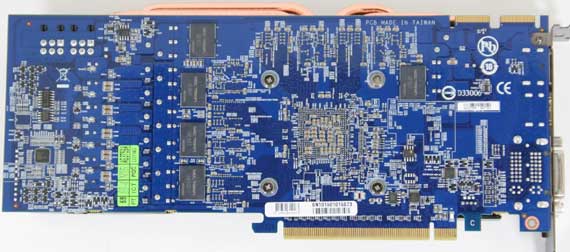
Getting down to business, at the base of the Super Overclock is Gigabyte’s custom PCB, measuring 10.5” long. The Super Overclock is part of Gigabyte’s Ultra Durable VGA family, with Gigabyte advertising that there’s 2 ounces of copper in the PCB. On the back side of the card are 6 LED lights representing the VRM power phases, and on the front side are voltage check points.
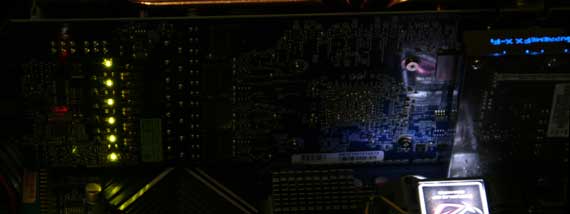
Unfortunately the implementation of the voltage check points makes them nearly useless – unlike MSI who provides cables for accessing the voltage check points on the Lightning, on the Super Overclock the voltage check points are merely very small contact points on the card itself. We have our doubts over whether anyone can easily reach these points, and it strikes us as a major oversight to not ape MSI all the way here.
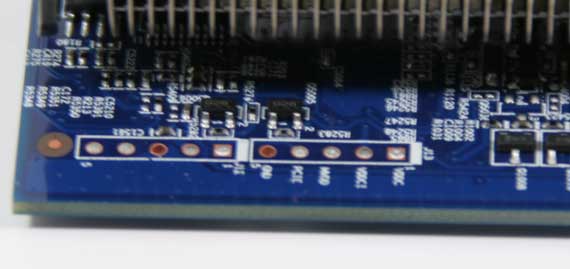
Moving on, component selection is similar to the other cards in our roundup. Trademark to their Ultra Durable line, Gigabyte is using solid state chokes and solid capacitors throughout the card. Also on the card are NEC Tokin Proadlizer decoupling capacitors, which Gigabyte is using along with MSI. Gigabyte makes this a significant marketing point, clearly advertising that they are using 5 of them, with all 5 laid out in an obvious manner on the back of the card. This also gives us an excellent opportunity to see a Proadlizer up close – at first glance they’re easy to mistake for a GDDR5 chip.

Powering the card is a pair of 6pin PCIe sockets. Although 8pin power sockets aren’t a necessity for overclocking, this along with the smaller number of VRM phases are the two strongest signs that Gigabyte is not targeting the extreme overclocker quite like MSI is.
For cooling Gigabyte is using an assembly that strongly resembles MSI’s Twin Frozr, making this the other reason we keep comparing the Super Overclock to the Lightning series. At the base is a card-sized heatsink with 4 heatpipes attaching the heatsink to the baseplate over the GPU, and over that a pair of 80mm fans with a partial cover. Interestingly unlike MSI who orients their fans parallel to the card, Gigabyte has slightly tilted the fans on the Super Overclock so that they face the center of the card. Gigabyte cites this as being done to minimize turbulence; however we don’t have any practical way to confirm that. Meanwhile the entire cooler is partially covered, directing the bulk of the airflow towards the front and rear of the card. So like every other card in this roundup, you’ll want a well-ventilated case for this card.

As we mentioned previously a big part of this card is the factory overclock. Gigabyte is shipping the card with a 950MHz core clock and 1.25GHz (5GHz effective) memory clock, making the Super Overclock the fastest factory overclocked 5870 that we’re aware of. This gives the Super Overclock a solid 100MHz (12%) over the reference 5870 on the core clock, and more petite 50MHz (200MHz effective, 4%) overclock on the memory.
Much of this comes down to Gigabyte’s extra binning of their chips through their GPU Gauntlet binning process, which allows them to sell completed boards as various products (Ultra Durrable, Overclock, Super Overclock) depending on the speed the complete board can reach. Unfortunately Gigabyte is using a non-standard VRM controller here and so we can’t read the core voltage with tools such as GPU-Z, but we believe the card ships at 1.18v.
Finally for the hardware side of things, as with the rest of the cards in our roundup today, Gigabyte is using the standard Eyefinity port configuration: 2xDVI, 1x DP, and 1x HDMI.
As for the software side of things, the 5870 Super Overclock marks the introduction of a new piece of overclocking software from Gigabyte: OC Guru. OC Guru is Gigabyte’s latest shot at a video card overclocking utility, and unfortunately due to Gigabyte’s use of a non-standard VRM controller, it’s the only way to read and control the card’s core voltage. In theory OC Guru has many of the hallmarks of a solid overclocking utility – overclocking profiles, voltage adjustment, and even an OSD, but it lacks any real hardware monitoring/logging support, rendering it only suitable for controlling the card as opposed to monitoring it.
Even then OC Guru fails to adhere to the KISS principle, a problem that many other manufacturer-supplied overclocking utilities also run in to. It’s poorly documented and unintuitive, laggy, and in the case of its power-consumption readouts flat-out wrong. We’ll give Gigabyte credit here for at least trying, but ultimately you aren’t going to want to use this utility for anything more than you have to: voltage adjustment.
For voltage adjustment Gigabyte lets you increase the core voltage by up to 0.1v, putting the maximum core voltage at 1.28v. As with the MSI Lightning this is more than the cooler can handle, and we found that in practice the cooler could only keep temperatures manageable up to 1.26v. We’ll have more on this later when we take a look at overclocking.
Finally the pack-in items are your usual assortment of bare-bones items: a fairly generic manual, a driver/utility CD, 2 4pin molex-to-PCIe power adaptors, a CF bridge, and a VGA dongle.
The retail price of the card is around $500, similar to the other cards in our roundup. As of this moment it looks to be readily available.


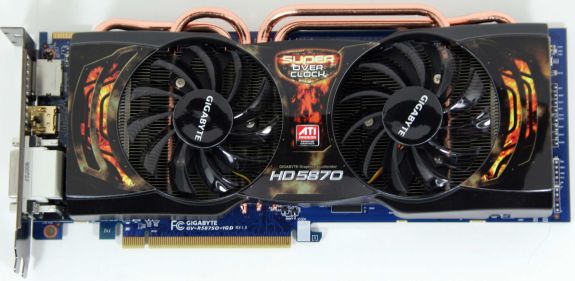
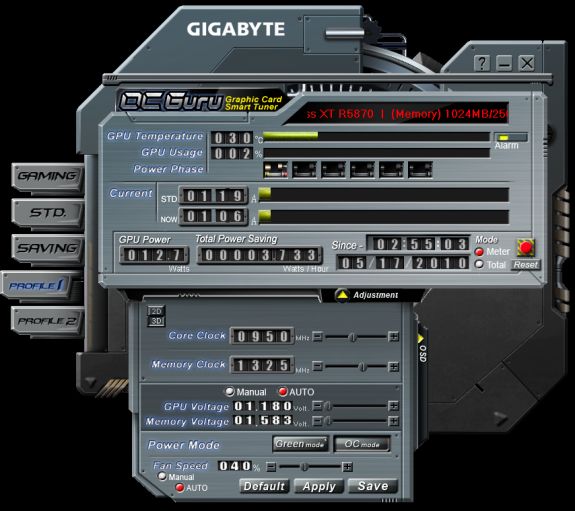








43 Comments
View All Comments
Jediron - Saturday, May 22, 2010 - link
These are not cards for a gamer, but for people who make it a sport to beat the other guys 3Dmark results.Gamers, you'll see it hardly makes a difference, gameexperience is something else then raw, digital FPS numbers. Save yourself alot of cash and buy a default clocked card; that leaves you with enough money to buy your favorite game ;)
cauchy2k - Thursday, May 20, 2010 - link
People should not take into account this near 100 °C ,becuase you can increase fan speeds and lower temps a lot.hglazm - Thursday, May 20, 2010 - link
Either you got a bad chip with the lightning, got an exceptional chip with the Toxic, or did something wrong when overclocking the lightningBecause both of mine hit 1ghz without issue. As well as three of the four 5770 HAWKs my friends have ordered (one hit 980 instead of 1020-1060).
Ninjahedge - Thursday, May 20, 2010 - link
It is always good to see this kind of thing being made and tested, but the thing that gets me is simple.This aint the Celery 300 days. You can't get the equivalent of a more expensive chip for half the price, boost it to 150% with a simple (was it multiplier?) switch and get 80%-90% of the more expensive brother.
I have not really seen much come out in the past few years that warrants throwing that much cash out on something that will be beaten for $100 less in 6 months.
Especially when there really is no game that would need it.
The fact that the makers are still comcentrating on giving you the fastest card that can show nose-hair and blackheads in 3D at 2560 resolution irritates me. Has there been any progress (or push for progress) in an EFFICIENT card that can do what the 4870, or 5800's can do for half the power? Passive (silent) cooling? Half the PRICE?
It would be great to get a card to use 1 6 pin additional power cable (hell, push it further, NO additional power) that would be able to fit into a compact case (Shuttle?) and not sound like a dust-buster in game.
Good article, but disappointing that this is still the direction card makers are going. (also sad that all that $$, all that noise and heat gets you so little in the end...)
Question, have you guys figured out a way to be able to rate the best Bang for the Watt? Some comparison taking compact, quiet, efficient cards and trying to rank them by speed, efficiency, ergonomics and price? Can that be done or is that too many variables?
mapesdhs - Tuesday, May 25, 2010 - link
Good post! I thoroughly agree. Reminds me of how pleased I was with the performance ofthe X1950 I bought in 2006 for 156 UKP, and then again later the excellent results obtained
from an 8800GT (Gigabyte Zalman, 700MHz core) which was only 120 UKP. Decent prices,
nice performance each time.
Prices now are crazy. I've given up waiting for a card that offers a reasonable speed boost
at any kind of similar price point, so instead I've bagged an extra identical 8800GT to have
SLI which should work quite well until the RAM limit becomes a factor (atm I'm not playing
games which need 1GB). I've done the same thing for my new PC build (i7 860), buying two
8800GTs which cost less than 100 UKP total.
As you say, it seems vendors are going all out for high cost cards, which is ironic given we're
supposed to be in the middle of a global recession. Who has the money to buy a $570 card
and sleep easy? On a tight budget, I managed to get some items 2nd-hand, saved a decent
amount (750W PSU 40% cheaper than new, WD VR 150GB half new price), and found an eBay
seller doing the i7 860 at a good price (205 UKP, almost 30 less than any other source) with
free shipping (item 270583690505; he has 5 left. Mine is only running at 3.8GHz atm, but I don't
have the proper fans yet).
When I bought the 8800GT in 2008, I doubled or tripled games fps rates compared to my old
X1950 using the same CPU/RAM (Athlon64 6000+, 4GB DDR2/800), for less than $200. Two
years on once more, doing the same thing isn't possible.
Ian.
Kaihekoa - Thursday, May 20, 2010 - link
Anandtech really needs to get a reliable proofreader. Every article I read has multiple typos which obviously isn't very professional for such a highly regarded tech site. I would do it for free given the subject matter.austonia - Thursday, May 20, 2010 - link
These cards do not OC very well at all. I have a reference-design Sapphire 5850 from about a month after they came out, and it does 900/1300 at stock 1.08v, and 1000/1300 at 1.25v. You would think these 5870s with cherry-picked chips, high end components and cooling system could at least match a stock 5850. And there were quite a few people on overclock.net forums getting similar results. Anyway thanks Anandtech, good info.austonia - Thursday, May 20, 2010 - link
Please consider adding Metro 2033 to the benchmarks, with all of the eyecandy turned up it looks like a slideshow on my 5850. Must need a brutal amount of power. None of the games you are testing now are very challenging for a Fermi or 5850+.Kaihekoa - Thursday, May 20, 2010 - link
I would like to extend my thanks to Anandtech for doing an article about PC hardware instead of writing laptop reviews and copy/pasting press releases. I believe this is a topic of great interest for gamers and hardware enthusiasts: How much benefit do you get out of these pre-overclocked cards with big price premiums. As we can see you don't get much and certainly not enough to justify paying $100 or more extra. I just upgraded my Radeon 4870 to a 5850 that overclocks to 950/5000 without extra voltage. Oh, and I paid $225 for it on ebay meaning I got almost as much performance as these $500 cards for 55% less money.Etern205 - Friday, May 21, 2010 - link
Why no this?http://vr-zone.com/articles/retail-asus-matrix-587...